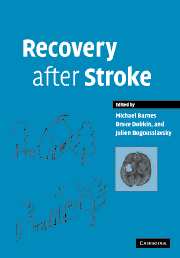Book contents
- Frontmatter
- Contents
- List of authors
- Preface
- 1 Stroke: background, epidemiology, etiology and avoiding recurrence
- 2 Principles of recovery after stroke
- 3 Regenerative ability in the central nervous system
- 4 Cerebral reorganization after sensorimotor stroke
- 5 Some personal lessons from imaging brain in recovery from stroke
- 6 Measurement in stroke: activity and quality of life
- 7 The impact of rehabilitation on stroke outcomes: what is the evidence?
- 8 Is early neurorehabilitation useful?
- 9 Community rehabilitation after stroke: is there no place like home?
- 10 Physical therapy
- 11 Abnormal movements after stroke
- 12 Spasticity and pain after stroke
- 13 Balance disorders and vertigo after stroke: assessment and rehabilitation
- 14 Management of dysphagia after stroke
- 15 Continence and stroke
- 16 Sex and relationships following stroke
- 17 Rehabilitation of visual disorders after stroke
- 18 Aphasia and dysarthria after stroke
- 19 Cognitive recovery after stroke
- 20 Stroke-related dementia
- 21 Depression and fatigue after stroke
- 22 Sleep disorders after stroke
- 23 Technology for recovery after stroke
- 24 Vocational rehabilitation
- 25 A patient's perspective
- Index
12 - Spasticity and pain after stroke
Published online by Cambridge University Press: 05 August 2016
- Frontmatter
- Contents
- List of authors
- Preface
- 1 Stroke: background, epidemiology, etiology and avoiding recurrence
- 2 Principles of recovery after stroke
- 3 Regenerative ability in the central nervous system
- 4 Cerebral reorganization after sensorimotor stroke
- 5 Some personal lessons from imaging brain in recovery from stroke
- 6 Measurement in stroke: activity and quality of life
- 7 The impact of rehabilitation on stroke outcomes: what is the evidence?
- 8 Is early neurorehabilitation useful?
- 9 Community rehabilitation after stroke: is there no place like home?
- 10 Physical therapy
- 11 Abnormal movements after stroke
- 12 Spasticity and pain after stroke
- 13 Balance disorders and vertigo after stroke: assessment and rehabilitation
- 14 Management of dysphagia after stroke
- 15 Continence and stroke
- 16 Sex and relationships following stroke
- 17 Rehabilitation of visual disorders after stroke
- 18 Aphasia and dysarthria after stroke
- 19 Cognitive recovery after stroke
- 20 Stroke-related dementia
- 21 Depression and fatigue after stroke
- 22 Sleep disorders after stroke
- 23 Technology for recovery after stroke
- 24 Vocational rehabilitation
- 25 A patient's perspective
- Index
Summary
Introduction
Since the studies of Sherrington(1947) on decerebrate rigidity in the cat, evidence has shown that spasticity is the result of modification of the sensitivity of the central reflex pathways. Lance defined spasticity in 1980 as a velocity-dependent increase in muscle tone in response to muscle stretch. This resistance to muscle stretch may also result in soft tissue modifications and eventually muscle and soft tissue contractures (Goldspink and Williams, 1990). In this way, it may limit movement and be a significant cause of disability and handicap. Usually spasticity is simply one part of the upper motor neuron syndrome and the other elements of the syndrome are responsible for further disability (Table 12.1).
Spasticity is a dynamic feature that can vary with the position of the limb or trunk, with time, with medication, and with a variety of other factors. Consequently, it is often difficult to evaluate the real impact of spasticity as an independent factor in its own right. The treatment must take into account all the features of the upper motor neuron syndrome, only some of which are responsive to clinical management. The main goal, as always in rehabilitation practice, is to identify the function limited by spasticity and introduce appropriate measures to improve that function. Sometimes a secondary goal can be simply to avoid unnecessary future complications associated with spasticity, such as contractures.
The aim of the first part of this chapter is to discuss the overall context of spasticity in terms of treatment decisions and outcome measures. The general management of spasticity will then be discussed both in terms of physical therapy and orthotic management as well as in terms of oral antispastic medication, focal treatments, and surgery. We will then discuss the management of various types of post-stroke pain, including hemiplegic shoulder pain.
Spasticity
Definition
Lance (1980) defined spasticity as “a motor disorder characterised by a velocity dependent increase in tonic stretch reflexes (muscle tone) with exaggerated tendon jerks, resulting fromhyperexcitability of the stretch reflex, as one component of the upper motor neurone syndrome.” There are three main mechanisms that induce spasticity: modification of the muscle, new nerve collaterals at the spinal level, and exaggeration of the spinal reflexes, which are not appropriatelymodulated by the supraspinal pathways (Brown, 1994; Young, 1994). It is likely that the perturbations of several of these mechanisms are necessary to produce clinical spasticity.
- Type
- Chapter
- Information
- Recovery after Stroke , pp. 286 - 319Publisher: Cambridge University PressPrint publication year: 2005
- 1
- Cited by



